GT2 Turbochargers Explained
#1
GT2 Turbochargers Explained
Hi guys. So recently we've had a few customers express some interest in GT2 turbos as an upgrade from their existing VTG's, so I thought I'd take a minute to show how the GT2 turbos are different from standard VTG's, and hopefully make some people's decisions on upgrades a little easier. A customer sent his factory GT2 turbos in for our CMS billet upgrade, so this was the perfect opportunity to snap a few pictures of the stock GT2 for reference. For the sake of this comparison, we'll be using 3 examples:
The picture below shows all 3 turbos side by side:
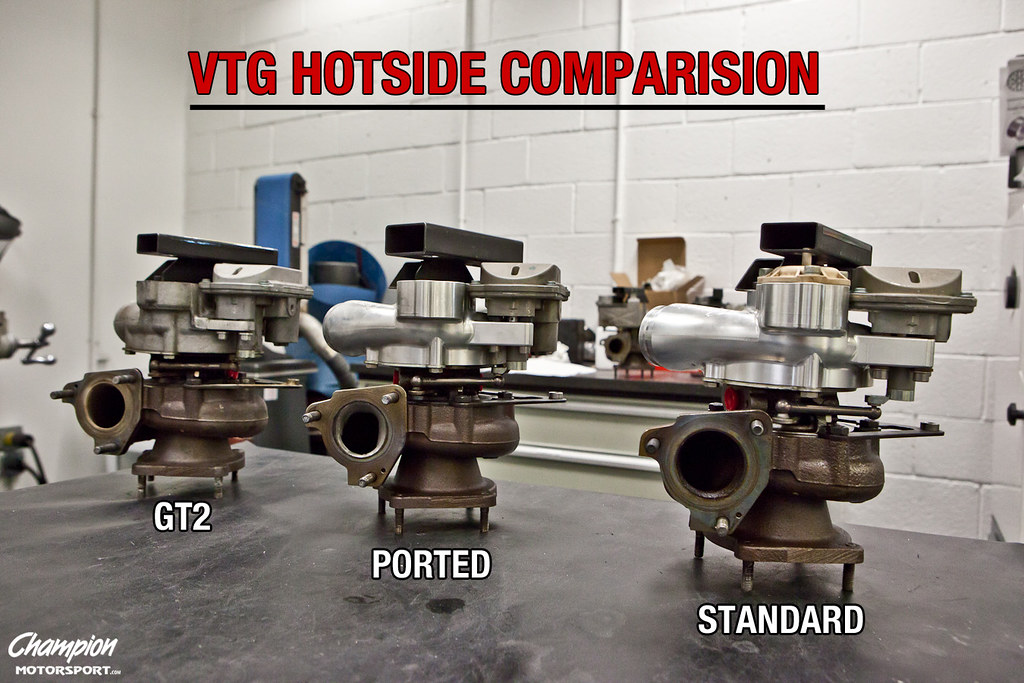
From the outside, the turbine housings look pretty much identical, but the GT2 turbine housing is actually made from a different material, to aid in cooling efficiency. That's the first difference.
The second difference is that the turbine wheel on a GT2 turbo is "clipped", which you can see on the closest edge of the turbine blades in the picture below. Notice the very small flat surface on each of the turbine blades. This is done to essentially slow the rotation of the turbine wheel and prevent it from spinning at a rate beyond the flow capacity of the compressor housing. By making sure that the turbine and compressor sides of the turbocharger are working in harmony, this again increases the turbochargers overall efficiency, which in turn reduces the amount of heat generated by the turbo.
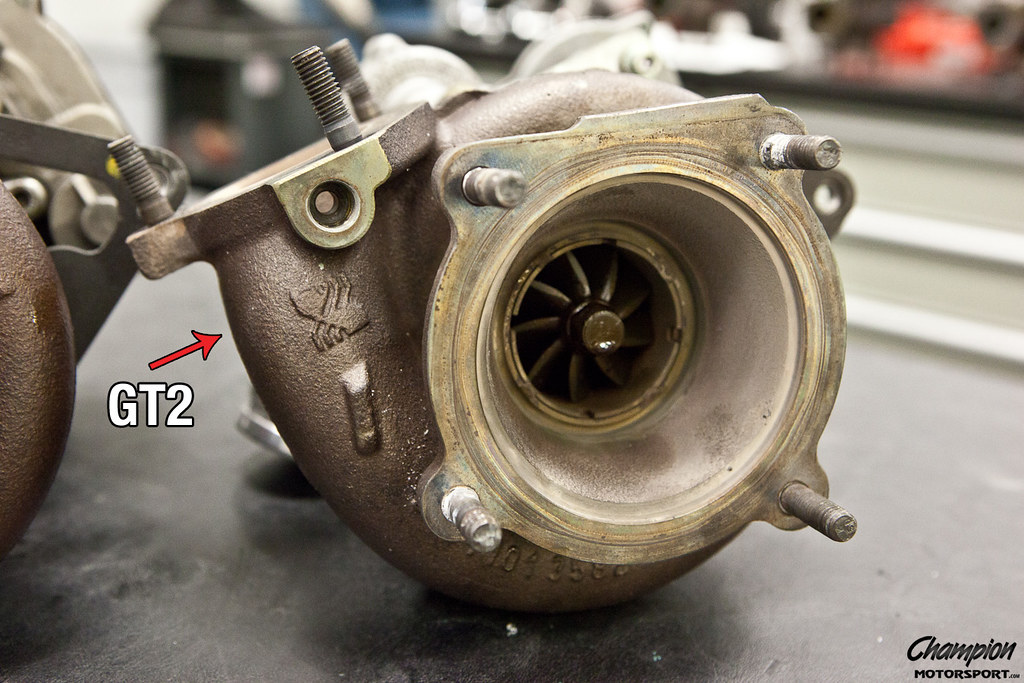
And lastly, the final unique thing about the factory GT2 VTG turbo is the "profile" of the turbine inlet, or effectively the A/R (area/radius) of the turbine inlet. As you can see in the picture below, the GT2 turbo has a much straighter inlet, again an attempt at increased efficiency. It also creates a slightly larger A/R for the GT2 turbine housing.
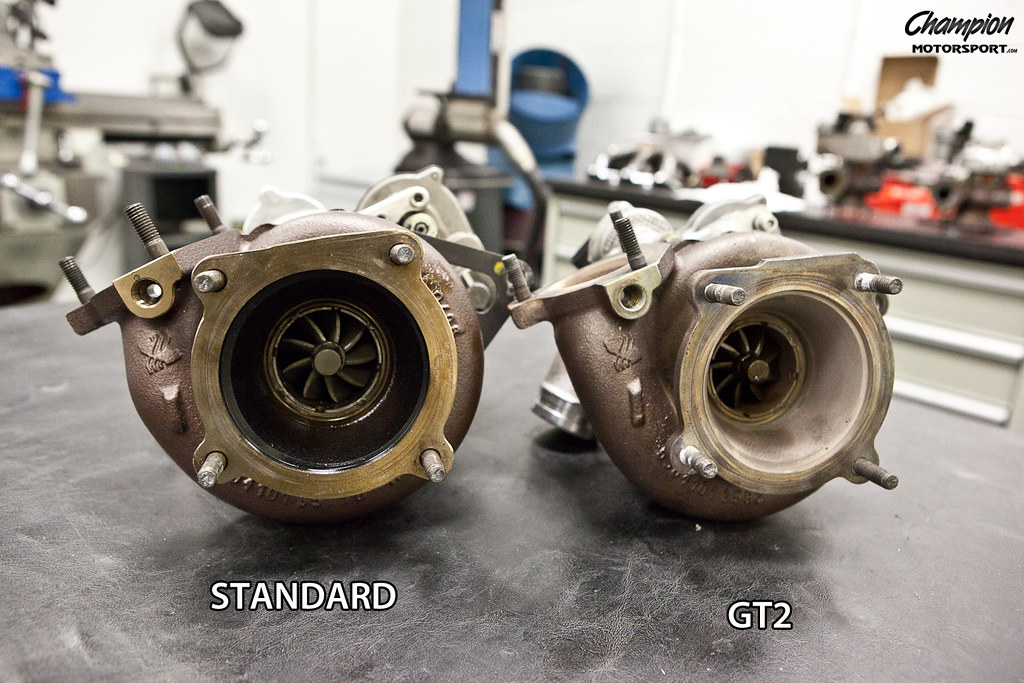
All VTG upgrades, including our own CMS Billet Turbos, leave the factory turbine housing intact, although we do make some proprietary changes to the turbine housing, such as clipping similar to the stock GT2 wheel. One thing we do offer as an option is porting of the turbine inlet. Unfortunately it's nearly impossible to extrude and hone the entire turbine housing because of the extremely fragile nature of the VTG vanes inside the housing, but porting is a good option for increasing efficiency of the inlet and creating a slightly larger effective A/R. In the two pictures below, you can see two comparisons: Stock VTG vs. GT2, and Stock VTG (ported) vs. GT2.
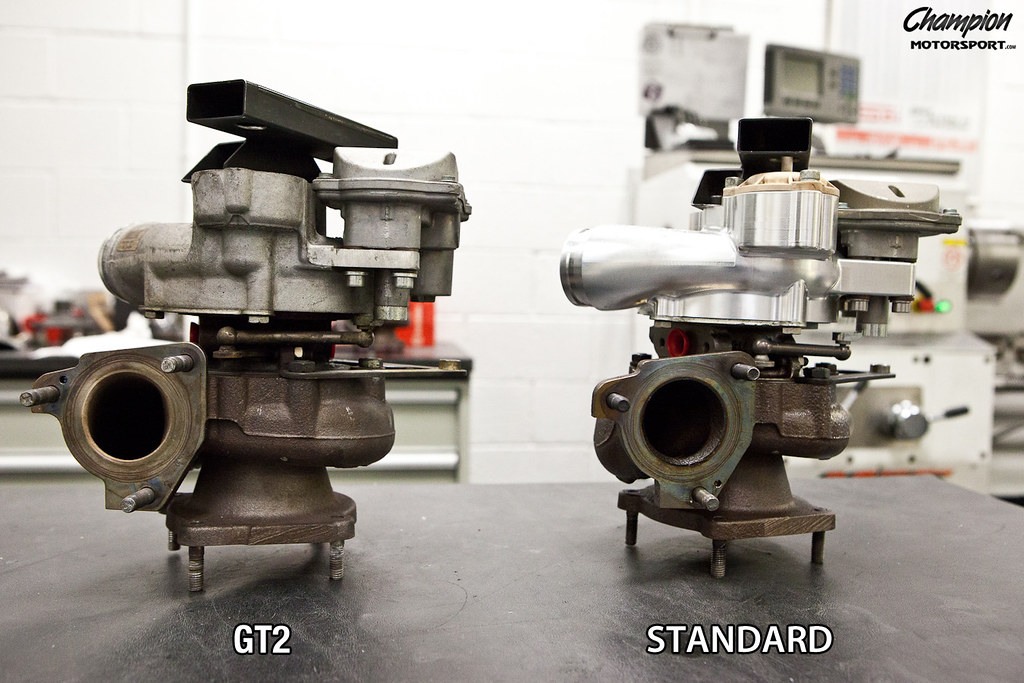
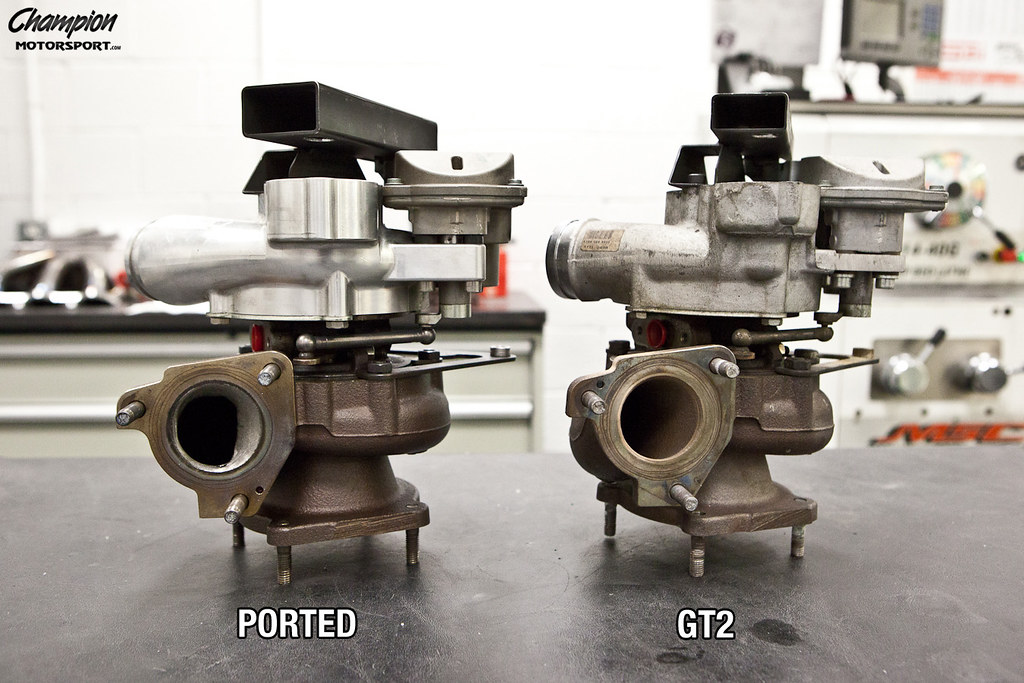
Although it's a bit difficult to see in the pictures, the ported inlet of the standard VTG turbine housing replicates the GT2's inlet profile much closer, again slightly increasing the A/R of the turbine inlet, which provides a much greater match to our redesigned billet compressor housings.
So, hopefully this little bit of information will be helpful to some folks who are undecided about which direction they want to go with turbochargers. Overall, although there ARE a few small differences between the stock VTG and the GT2 VTG, the big question everyone wants to know is how this translates to power. Will GT2 turbos offer a slight power upgrade compared to standard turbos....yes. But, realistically the gains you can expect are going to be minimal. The most notable gain will be in efficiency. Any time you can improve efficiency, you're likely to gain power. How much power depends largely on the quality and performance of all your other hardware upgrades.
- Stock GT2 Turbo
- Standard Champion Billet Turbo
- Champion Billet Turbo with ported exhaust inlet
The picture below shows all 3 turbos side by side:

From the outside, the turbine housings look pretty much identical, but the GT2 turbine housing is actually made from a different material, to aid in cooling efficiency. That's the first difference.
The second difference is that the turbine wheel on a GT2 turbo is "clipped", which you can see on the closest edge of the turbine blades in the picture below. Notice the very small flat surface on each of the turbine blades. This is done to essentially slow the rotation of the turbine wheel and prevent it from spinning at a rate beyond the flow capacity of the compressor housing. By making sure that the turbine and compressor sides of the turbocharger are working in harmony, this again increases the turbochargers overall efficiency, which in turn reduces the amount of heat generated by the turbo.

And lastly, the final unique thing about the factory GT2 VTG turbo is the "profile" of the turbine inlet, or effectively the A/R (area/radius) of the turbine inlet. As you can see in the picture below, the GT2 turbo has a much straighter inlet, again an attempt at increased efficiency. It also creates a slightly larger A/R for the GT2 turbine housing.

All VTG upgrades, including our own CMS Billet Turbos, leave the factory turbine housing intact, although we do make some proprietary changes to the turbine housing, such as clipping similar to the stock GT2 wheel. One thing we do offer as an option is porting of the turbine inlet. Unfortunately it's nearly impossible to extrude and hone the entire turbine housing because of the extremely fragile nature of the VTG vanes inside the housing, but porting is a good option for increasing efficiency of the inlet and creating a slightly larger effective A/R. In the two pictures below, you can see two comparisons: Stock VTG vs. GT2, and Stock VTG (ported) vs. GT2.


Although it's a bit difficult to see in the pictures, the ported inlet of the standard VTG turbine housing replicates the GT2's inlet profile much closer, again slightly increasing the A/R of the turbine inlet, which provides a much greater match to our redesigned billet compressor housings.
So, hopefully this little bit of information will be helpful to some folks who are undecided about which direction they want to go with turbochargers. Overall, although there ARE a few small differences between the stock VTG and the GT2 VTG, the big question everyone wants to know is how this translates to power. Will GT2 turbos offer a slight power upgrade compared to standard turbos....yes. But, realistically the gains you can expect are going to be minimal. The most notable gain will be in efficiency. Any time you can improve efficiency, you're likely to gain power. How much power depends largely on the quality and performance of all your other hardware upgrades.
#4
Very nice. Thanks for sharing. Do you know what's the actual a/r ratio for standard and gt2? Also, do you have any specs on the turbine wheel when the vanes are fully displayed, inducer/exducer size?
#6
A gt2 turbo has a slightly larger compressor wheel, like 1.4mm
A gt2 turbo has a larger turbine housing
A gt2 turbo has the same turbine wheel, but it’s back cut to 15deg vs. 7.5deg.
The compressor housing is machined to fit the larger compressor wheel.
Fitment is identical.
A gt2 turbo has a larger turbine housing
A gt2 turbo has the same turbine wheel, but it’s back cut to 15deg vs. 7.5deg.
The compressor housing is machined to fit the larger compressor wheel.
Fitment is identical.
#7
nice write, i see that you do port hot sides. I remember you were not a fun of that mod a while ago
thank you for taking the time to explain

thank you for taking the time to explain
Trending Topics
#8
Tom, killer post, but we noticed some points that are incorrect.
The standard compressor wheel is different on the 997.1 turbo, the GT2 wheel is larger. It is the same on the 997.2 but the compressor housing is different.
Info on wheel sizes and turbine material from the BW catalogue:
GT2 Borg Warner turbocharger specification:
BV50-2280DCB426.10BVAX0
997.1TT Borg Warner turbocharger specification:
BV50-2277DCB405.10BVAX0
997.2TT Borg Warner turbocharger specification:
BV50-2280DCB426.10BVAX0
The four numbers in RED indicate the compressor wheel size. All have the same size exducer, 56mm. The 997.1 inducer is 43mm and the GT2 and 997.2 inducer is 45mm.
The last letter that is bold and underlined indicates the turbine material. In this case O stands for Austenitic stainless steel, which is specially formulated to withstand high EGTs.
Actually, as I pointed out above, the housings are made of the same material according to Borg Warner spec.
Your cooling statement is inaccurate as well. Heat should be kept in the turbo, turbine housings are never cooled. That is why you see some people wrap their turbos or even coat them. You want to keep the energy inside the turbo and not dissipate it. Please don't confuse this with exhaust gas temperature...that is an entirely different conversation.
This is also technically not correct.
Rotational speed is controlled by the vanes, the blade profile is not a factor. Clipping the wheel is to decrease back pressure and therefore EGTs at steady state operation. This raises the flow limit of the turbine to better match the larger compressor wheel.
Since the factory GT2 turbo uses the same compressor housing and wheel as the standard VTG we'll focus on the turbine side, which is where the differences are. There are basically 3 differences between a stock GT2 VTG turbo and a stock VTG, all 3 are on the turbine side.
Info on wheel sizes and turbine material from the BW catalogue:
GT2 Borg Warner turbocharger specification:
BV50-2280DCB426.10BVAX0
997.1TT Borg Warner turbocharger specification:
BV50-2277DCB405.10BVAX0
997.2TT Borg Warner turbocharger specification:
BV50-2280DCB426.10BVAX0
The four numbers in RED indicate the compressor wheel size. All have the same size exducer, 56mm. The 997.1 inducer is 43mm and the GT2 and 997.2 inducer is 45mm.
The last letter that is bold and underlined indicates the turbine material. In this case O stands for Austenitic stainless steel, which is specially formulated to withstand high EGTs.
Your cooling statement is inaccurate as well. Heat should be kept in the turbo, turbine housings are never cooled. That is why you see some people wrap their turbos or even coat them. You want to keep the energy inside the turbo and not dissipate it. Please don't confuse this with exhaust gas temperature...that is an entirely different conversation.
Rotational speed is controlled by the vanes, the blade profile is not a factor. Clipping the wheel is to decrease back pressure and therefore EGTs at steady state operation. This raises the flow limit of the turbine to better match the larger compressor wheel.
#14
Tom, killer post, but we noticed some points that are incorrect.
The standard compressor wheel is different on the 997.1 turbo, the GT2 wheel is larger. It is the same on the 997.2 but the compressor housing is different.
Info on wheel sizes and turbine material from the BW catalogue:
GT2 Borg Warner turbocharger specification:
BV50-2280DCB426.10BVAX0
997.1TT Borg Warner turbocharger specification:
BV50-2277DCB405.10BVAX0
997.2TT Borg Warner turbocharger specification:
BV50-2280DCB426.10BVAX0
The four numbers in RED indicate the compressor wheel size. All have the same size exducer, 56mm. The 997.1 inducer is 43mm and the GT2 and 997.2 inducer is 45mm.
The last letter that is bold and underlined indicates the turbine material. In this case O stands for Austenitic stainless steel, which is specially formulated to withstand high EGTs.
Actually, as I pointed out above, the housings are made of the same material according to Borg Warner spec.
Your cooling statement is inaccurate as well. Heat should be kept in the turbo, turbine housings are never cooled. That is why you see some people wrap their turbos or even coat them. You want to keep the energy inside the turbo and not dissipate it. Please don't confuse this with exhaust gas temperature...that is an entirely different conversation.
This is also technically not correct.
Rotational speed is controlled by the vanes, the blade profile is not a factor. Clipping the wheel is to decrease back pressure and therefore EGTs at steady state operation. This raises the flow limit of the turbine to better match the larger compressor wheel.
The standard compressor wheel is different on the 997.1 turbo, the GT2 wheel is larger. It is the same on the 997.2 but the compressor housing is different.
Info on wheel sizes and turbine material from the BW catalogue:
GT2 Borg Warner turbocharger specification:
BV50-2280DCB426.10BVAX0
997.1TT Borg Warner turbocharger specification:
BV50-2277DCB405.10BVAX0
997.2TT Borg Warner turbocharger specification:
BV50-2280DCB426.10BVAX0
The four numbers in RED indicate the compressor wheel size. All have the same size exducer, 56mm. The 997.1 inducer is 43mm and the GT2 and 997.2 inducer is 45mm.
The last letter that is bold and underlined indicates the turbine material. In this case O stands for Austenitic stainless steel, which is specially formulated to withstand high EGTs.
Actually, as I pointed out above, the housings are made of the same material according to Borg Warner spec.
Your cooling statement is inaccurate as well. Heat should be kept in the turbo, turbine housings are never cooled. That is why you see some people wrap their turbos or even coat them. You want to keep the energy inside the turbo and not dissipate it. Please don't confuse this with exhaust gas temperature...that is an entirely different conversation.
This is also technically not correct.
Rotational speed is controlled by the vanes, the blade profile is not a factor. Clipping the wheel is to decrease back pressure and therefore EGTs at steady state operation. This raises the flow limit of the turbine to better match the larger compressor wheel.
Awesome info!! Thanks for sharing!! Any spec info on the turbine wheel, a/r ratio, etc...? There seems to be a lot of info for the compressor side but nothing for the turbine.
Last edited by TTdude; 01-04-2011 at 04:52 PM.
#15
I believe Mike is correct. The 2270 designation appears to mean 2.2" (56 mm exducer) and 70% of that for inducer (= 43 mm). Similarly for 2280.





 Ouch
Ouch

